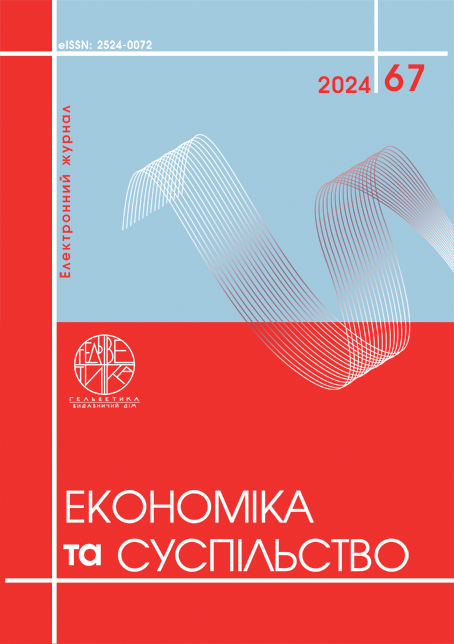СУЧАСНІ ПІДХОДИ ДО РОЗУМІННЯ РОЛІ МІСЬКИХ АГЛОМЕРАЦІЙ У СТАЛОМУ РОЗВИТКУ НАЦІОНАЛЬНОЇ ЕКОНОМІКИ
Анотація
У статті узагальнено основні точки зору зарубіжних та вітчизняних дослідників щодо розуміння ролі міських агломерацій у сталому розвитку національної економіки. Уточнено сутність міської агломерації. Проаналізовано переваги та позитивні ефекти міських агломерацій, наведені у наукових публікаціях. На основі аналізу наявних наукових підходів автором встановлено, що одним із основних чинників позитивного впливу міських агломерацій на економічне зростання, продуктивність праці, якість життя населення є виникнення агломераційного ефекту. Уточнено сутність агломераційного ефекту. Здійснено систематизацію складових агломераційного ефекту та окреслено їх вплив на сталий розвиток економіки. Отримані результати будуть корисними для використання при розробленні напрямів удосконалення організаційно-економічних аспектів функціонування міських агломерацій в Україні.
Посилання
Сірик З. О., Засадній В. Л. Теоретичні засади дослідження агломераційних чинників інвестиційної привабливості громад. Український журнал прикладної економіки та техніки. 2024. Том 9. № 1. С. 302–309.
Дронова О. Л., Лис Я. С. Управління міськими агломераціями: європейський досвід для реформ в Україні. Український географічний журнал. 2016. № 1. С. 47–52.
Іщук С. І., Гладкий О. В. Географія промислових комплексів. Підручник. Київ : Знання, 2011. 375 с.
Ліщинський І. Нова економічна географія та альтернативні концепції агломерації виробництва. Журнал європейської економіки. 2009. Том 8 (№ 3). С. 241–264.
Пелехатий А. О., Патицька Х. О. Міська агломерація як механізм взаємодії територіальних громад в умовах адміністративно-фінансової децентралізації в Україні. Вчені записки ТНУ імені В. І. Вернадського. Серія: Економіка і управління. 2019. Том 30(69). № 3. С. 116–123.
Яровенко Т. С., Дон О. Д., Федоров Г. А. Урбанізація та агломерація як сучасні світові процеси економічного розвитку. Східна Європа: економіка, бізнес та управління. 2020. Вип. 1(24). С. 38–45.
Шевчук В. О. Агломераційні ефекти в сучасних економіках. URL: http://mev.lac.lviv.ua/downloads/vyklad/shevch/Shevchuk-08-3aglomeration_20.pdf
Кізима Р. Про Львівську агломерацію як «вищу лігу» місцевого самоврядування. 2023. URL: https://zaxid.net/pro_lvivsku_aglomeratsiyu_yak_vishhu_ligu_mistsevogo_samovryaduvannya_n1558625
Степаненко А. В., Омельченко А. А. Міські агломерації як форма сучасного світового процесу урбанізації. Держава та регіони. Серія: Економіка та підприємництво. 2019. № 3(108). С. 184–192.
Прибиткова І. М. Еволюція міської цивілізації і післяміські форми розселення в Україні. Український соціум. 2015. № 1(52). С. 92–104.
Swinney P., Vera O. Office politics: London and the rise of home working. 2023. URL: https://www.centreforcities.org/reader/office-politics/foreword/
Bertinelli L., Black D. Urbanization and growth. Journal of Urban Economics. 2004. Vol. 56(1). P. 80–96.
Ahrend R., Lembcke A., Schumann A. The Role of Urban Agglomerations for Economic and Productivity Growth. International Productivity Monitor. 2017. Vol. 32. URL: https://www.csls.ca/ipm/32/Ahrend_Lembcke_Shumann.pdf
Wang S., Yang C., Hou D., Dai L. How do urban agglomerations drive economic development? A policy implementation and spatial effects perspective. Economic Analysis and Policy. 2023. Vol. 80(1). URL: https://ideas.repec.org/a/eee/ecanpo/v80y2023icp1224-1238.html
Yoo C., Xiao H., Zhong O., Weng O. Unequal impacts of urban industrial land expansion on economic growth and carbon dioxide emissions. 2024. URL: https://www.researchgate.net/publication/379835601
Fang C. Scientifically selecting and hierarchically nurturing China’s urban agglomerations for the new normal. Bulletin of the Chinese Academy of Sciences. 2015. Vol. 30(2). P. 127–136.
Siryk Z. O., Zasadnii V. L. (2024) Teoretychni zasady doslidzhennia ahlomeratsiinykh chynnykiv investytsiinoi pryvablyvosti hromad [Theoretical foundations of the study of agglomeration factors of the investment attractiveness of communities]. Ukrainskyi zhurnal prykladnoi ekonomiky ta tekhniky, no 9(1), pp. 302–309. (in Ukrainian)
Dronova O. L., Lys Ya. S. (2016) Upravlinnia miskymy ahlomeratsiiamy: yevropeiskyi dosvid dlia reform v Ukraini [Management of urban agglomerations: European experience for reforms in Ukraine]. Ukrainskyi heohrafichnyi zhurnal, no 1, pp. 47–52. (in Ukrainian)
Ishchuk S. I., Hladkyi O. V. (2011) Heohrafiia promyslovykh kompleksiv [Geography of industrial complexes]. Kyiv : Znannia. 375 p. (in Ukrainian)
Lishchynskyi I. (2009) Nova ekonomichna heohrafiia ta alternatyvni kontseptsii ahlomeratsii vyrobnytstva [New economic geography and alternative concepts of production agglomeration]. Zhurnal yevropeiskoi ekonomiky, no 8(3), pp. 241–264. (in Ukrainian)
Pelekhatyi A. O., Patytska Kh. O. (2019) Miska ahlomeratsiia yak mekhanizm vzaiemodii terytorialnykh hromad v umovakh administratyvno-finansovoi detsentralizatsii v Ukraini [Urban agglomeration as a mechanism of interaction of territorial communities in the conditions of administrative and financial decentralization in Ukraine]. Vcheni zapysky TNU imeni V. I. Vernadskoho. Seriia: Ekonomika i upravlinnia, no 30(69), pp. 116–123. (in Ukrainian)
Yarovenko T. S., Don O. D., Fedorov H. A. (2020) Urbanizatsiia ta ahlomeratsiia yak suchasni svitovi protsesy ekonomichnoho rozvytku [Urbanization and agglomeration as modern world processes of economic development]. Skhidna Yevropa: ekonomika, biznes ta upravlinnia, no 1(24), pp. 38–45. (in Ukrainian)
Shevchuk V. O. Ahlomeratsiini efekty v suchasnykh ekonomikakh [Agglomeration effects in modern economies]. Available at: http://mev.lac.lviv.ua/downloads/vyklad/shevch/Shevchuk-08-3aglomeration_20.pdf
Kizyma R. (2023) Pro Lvivsku ahlomeratsiiu yak «vyshchu lihu» mistsevoho samovriaduvannia [About the Lviv agglomeration as the "higher league" of local self-government]. Available at: https://zaxid.net/pro_lvivsku_aglomeratsiyu_yak_vishhu_ligu_mistsevogo_samovryaduvannya_n1558625
Stepanenko A. V., Omelchenko A. A. (2019) Miski ahlomeratsii yak forma suchasnoho svitovoho protsesu urbanizatsii [Urban agglomerations as a form of the modern world process of urbanization]. Derzhava ta rehiony. Seriia: Ekonomika ta pidpryiemnytstvo, no 3(108), pp. 184–192. (in Ukrainian)
Prybytkova I. M. (2015) Evoliutsiia miskoi tsyvilizatsii i pisliamiski formy rozselennia v Ukraini [Evolution of urban civilization and post-urban forms of settlement in Ukraine]. Ukrainskyi sotsium, no 1(52), pp. 92–104. (in Ukrainian)
Swinney P., Vera O. (2023) Office politics: London and the rise of home working. Available at: https://www.centreforcities.org/reader/office-politics/foreword/
Bertinelli L., Black D. (2004) Urbanization and growth. Journal of Urban Economics, no 56(1), pp. 80–96.
Ahrend R., Lembcke A., Schumann A. (2017) The Role of Urban Agglomerations for Economic and Productivity Growth. International Productivity Monitor, no 32. Available at: https://www.csls.ca/ipm/32/Ahrend_Lembcke_Shumann.pdf
Wang S., Yang C., Hou D., Dai L. (2023) How do urban agglomerations drive economic development? A policy implementation and spatial effects perspective. Economic Analysis and Policy, no 80(1). Available at: https://ideas.repec.org/a/eee/ecanpo/v80y2023icp1224-1238.html
Yoo C., Xiao H., Zhong O., Weng O. (2024) Unequal impacts of urban industrial land expansion on economic growth and carbon dioxide emissions. Available at: https://www.researchgate.net/publication/379835601
Fang C. (2015) Scientifically selecting and hierarchically nurturing China’s urban agglomerations for the new normal. Bulletin of the Chinese Academy of Sciences, no 30(2), pp. 127–136.

Ця робота ліцензується відповідно до Creative Commons Attribution 4.0 International License.


